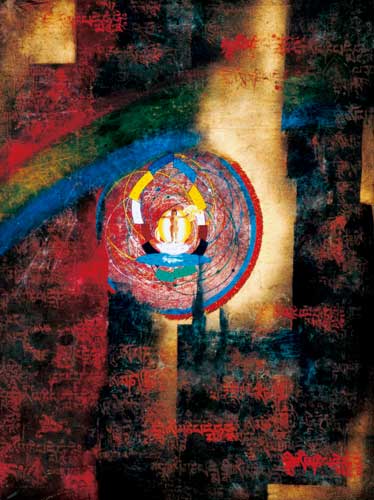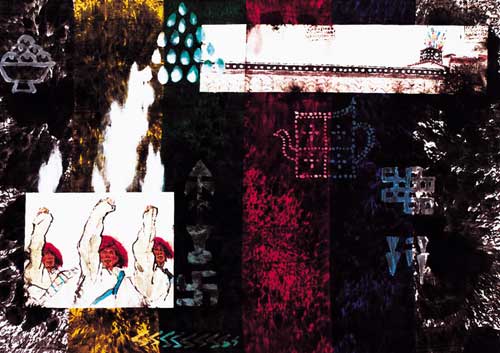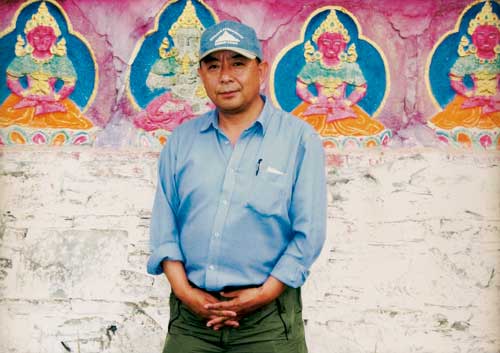| Homepage |
| New books |
| News in Brief |
| list of late magazines |
| Articles Recommended |
Articles Recommended |
|
· Tibetan Thangka Painter -- ... · Art Gallery in Lhasa · The Most Charming Pictures · Ngawang Jigme's Modern Wash... · Unique Illustrations in Tib... · Introduction of the K??la... · "Six Symbols of Longevity" ... · Humid acid · NEWS IN BRIEF · THE LAST TRADE CARAVAN IN T... · NYINGCHI, THE NATURAL BEA... · Tibetan Football · Horse Race in North Tibet · The Life of Herder Dargye · Transportation in Lhasa Cit... |
Ngawang Jigme's Modern Wash Paintings
By Kelzang Dorje

Ancient Civilization at the Snow-covered Land
Having received a thorough college education, Ngawang Jigme naturally expresses his academic knowledge and skills through his washing paintings. Though he grew up on the plateau eating Tampa and yak flesh, drinking yak buttered tea, living in the clear atmosphere, sunny sky and mountain scenery, he would hardly be expected to tolerate the monotone world of wash painting, which adopts black and white as its principal theme and acknowledges "blur impression" as the ultimate aim. He strives for total absorption into in the wash painting world. While imitating ancient classic oil paintings, he is adopting a totally modern approach in his paintings and gradually ridding himself of all his traditional influences, one after another.
About ten years ago, Ngawang Jigme found a way in which he could not only purify his art and its effects but also completely follow his heart and his Tibetan heritage.
Tibetan traditional culture is indivisibly connected with Tibetan religion. Nevertheless, modern Tibet has completely dismantled the federal system inherited over thousands of years and broken the cultural monopoly that once fully controlled the religion of old Tibet. Ngawang Jigme represents a group of local Tibetans living in new cultural circumstance, having received a modern education. These people are not only proud of their fine and abundant culture inherited from their ancestors, but also actively reshape the culture to make it more significant. Ngawang Jigme is deeply aware that he is in such an unusual and rapidly changing era. He needs to represent to the art audience the features and visual language of this special era through his painting. But for sure, this should take place within the distinctive characteristics of Tibetan art.

Tsampa with Auspiciousness
Ngawang Jigme usually chooses five single colours to use each of them in turn as the keynote or background of his many artworks. The paintings are made so much more attractive by the adoption of strong and dominant colours. This method of presentation originated from the five colours of the Bon religion, which was practiced locally before Buddhism was introduced into Tibet. The colours include blue, white, red, yellow and green. The universal mantra (On Mani Padme Hum), which was drawn by taking these five colours as the base, is actually the supreme belief of Tibetans ?C the essential doctrine of Buddhism.
Ngawang Jigme believes, if these two parallel concepts (Five colours and the universal mantras) are taken as the symbols of Tibet, Tibetan traditional culture and the traditional consciousness of Tibetan people will be perfectly blended. They enable people to both feel and taste Tibet no matter where, when or by whom.
Even today, despite the passing of time, the five colours or the universal mantra, are all actively and constantly alive in the minds, lives and environment of Tibetans. However, in consideration of contemporary Tibetan art and the development of Tibet as a whole, these two concepts have already retreated to the background of a big stage; they only act as a setting or a theme. In contrast, on such a big and active stage, the plays being performed are not uniform but rather diversified. Naturally, such changes enabled Ngawang Jigme to take evolving methods and a distinctive painting language to depict all that happens on the snow- covered plateau and show what he really wants to tell from his heart.

Ngawang Jigme
It is as Xinyi (an art theoretician) commented on Ngawang Jigme's artworks in the paper "Step out Tibet ?C records of the National Painter Ngawang Jigme". He said: "The Chinese painting in particular concerns the mutually-accepted best amongst poetry, calligraphy, pictures, and stamps displayed on a drawing, and pays more attention to flavour and artistic conception. But Ngawang Jigme does not like to follow traditional rules. Due to the difference of ethnic Tibetan culture itself, a stamp is not used the same way as in Han culture. Therefore, Ngawang Jigme not only creatively and realistically portrays people and their activities with Tibetan characteristics on rice papers by using the pigments of national painting, but also draws Thangkas with auspicious patterns, and nonfigurative paintings on clothes using Tibetan traditional pigments and wash painting. He cleverly mounts the pictures drawn on rice papers onto clothes painted to form a particular effect in terms of perfectly showing falsehood versus reality, and vacancy versus occupation. For instance, Tibetan ??wind horse' prayer flags are usually painted on both paper and clothes, which create the illusion of one integrated mass. In Ngawang Jigme's opinion, the auspicious patterns are already the stamps and painting itself are stamps too. As a national painter and also a Tibetan, Ngawang Jigme never forgets his cultural tradition and he would also never drop the characteristics of national painting. By taking these two into consideration, he successfully produces his modern Chinese national pictures in which, on one hand, it shows his deep affections and thoughts of life. On the other hand, it embodies his unusual approach to creativity and unique art quality. Ngawang Jigme's efforts enable him not only to be celebrated by professional authorities from both home and abroad, but also bring a fresh wind into the camp of Chinese national painting. Ngawang Jigme said: ??If we strive to study the skills and artifice of traditional Chinese national painting, and at the same time we should integrate those with the skills, artifice and ideology of Tibetan painting. By only doing this, we can produce some pieces of art featuring full-bodied Tibetan culture and which could be acknowledged by all traditional national painters. In addition, the paintings could leave Tibet and be enjoyed by fans of Chinese national painting'. Though many Tibetans have the same name as Ngawang Jigme, he may be the only one in Tibet who could produce such wonderful examples of the national painting style. This might be the heart of art production".
To take pleasure in the modern wash paintings of Ngawang Jigme, the rhythm of drawing naturally flows all over the clothes in five colours, sympathetically responding to the visual effects of the unique culture of Tibetan characters. It makes you not only sense a broad and deep culture steeped with thousands of years in the snowed-covered land and the earthy folklore culture of Tibetans, but also perceive the new lives of Tibetans and their energetic and enthusiastic spirits by observing the diversified windows and figures presented in the paintings. Such pictures lead every individual who is fond of Tibetan art to step into a new, virgin and innocent art chamber on the snow land. .